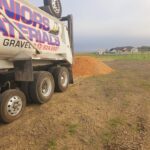What Is The Method For Concrete Culvert Installation in Austin, Tx?

What Is The Method For Concrete Culvert Installation in Austin, Tx
If your property is prone to flooding, soil erosion and other issues that could lead to significant damage, you should consider concrete culvert installation in Austin. Drain culverts can benefit many types of properties. You’re most likely to see them under roads, bridges and driveways, but culverts are an important part of civil engineering that can prevent costly damages.
In this blog, you’ll learn more about Austin culvert installation, the various options for your project and why you might need them.
What is Concrete Culvert Installation in Austin?
Austin culvert installation is an important service offered by soil sinking contractors. Culverts are an underground drainage system that diverts water away from areas prone to flooding. A seasoned soil sinking contractor can engineer your culvert system to protect your property and prevent disaster.
There are many ways to use drain culverts. As mentioned earlier, they’re common under bridges and roads. However, they’re also common on residential properties. A driveway culvert runs perpendicular to your driveway, allowing water to flow through without moving over a front lawn.
The purpose of a culvert is to prevent water-caused damage, such as soil erosion, sinking, foundation problems, etc.
What are the Benefits of Concrete Installation?
Service from an Austin soil sinking contractor can benefit you in many ways. Culverts are protective systems that ensure water goes where you need it to. While you may not require a driveway culvert every day of the year in Austin, you’ll be happy to have one when heavy rains cause significant issues.
Proper installation from a soil sinking contractor promotes proper drainage, moving water away from your home’s foundation, around obstacles and more. Drain culverts are a relatively cost-effective solution to major drainage headaches like flooding.
Concrete culverts are versatile enough for various applications. They work in both urban and rural settings and across multiple soil types. If you’re unsure if a drain culvert will benefit your property, consider hiring an Austin soil sinking contractor for guidance.
What Types of Culvert Installation Options are Available?
When you invest in a culvert drain, several design and installation options exist. The first is open-bottom box culverts. These culverts are relatively easy to install, and you’re most likely to see them under bridges and driveways with a stream. As the name implies, they have no bottom, preserving natural stream substrates.
Your next option is a corrugated steel pipe. Steel culvert pipes act as trenches to direct water. This choice is cost-effective and requires little work after installation.
Finally, there are concrete culverts. These culverts are the most prevalent due to their affordability and ease of installation. Your soil sinking contractor can connect multiple concrete pipes to achieve proper drainage on any site. Concrete pipes come in various diameters, and the material provides optimal long-term strength.
What Preparation Work Needs to Occur Before Installation in Austin?
Like any other construction project, culvert installation starts with good site prep. Your Austin soil sinking contractor will excavate the site, remove all vegetation and level the area. Then, teams will create a trench based on the engineering plans of your drain culvert.
The concrete pipes will sit in the trenches. To prevent cave-ins, teams typically place reinforcing steel bars at both ends.
Once the site is ready, contractors will use cranes and heavy machinery to bring in the concrete pipes. Concrete pipes are engineered to connect, creating a waterproof seam no matter how long the culvert is. After filling the area surrounding the culvert pipes with concrete, teams allow the material to cure before leveling the surrounding soil.
Does Driveway Culvert Placement Matter?
Placement and positioning are crucial in culvert installation. First, your Austin soil sinking contractor must ensure the trench and culvert pipes sit at an angle away from the land or structure you’re trying to protect. This positioning assures that water flows away from the area.
Secondly, culverts can’t be close to trees, power lines and other structures.
Finally, culvert pipes must not be below the frost line or in a trench too wide or deep. In both cases, improper placement increases the risk of culvert overflow, resulting in water flowing into the ground and causing damage.
Junior’s Materials is here to help when you need culvert installation in Austin. We’re a hauling, material and soil sinking contractor proudly serving property owners in Austin and the surrounding areas. We’ve been in business for over a decade and have hundreds of successful projects under our belt. We aim to deliver great service you can trust, no matter how complex your job seems.
In addition to culvert installation, we do road base installation, landscape material delivery, grading, decomposed granite delivery, skid steer operation and more.
Call Junior’s Materials at (512)924-6887 or email juniorsmaterials2@gmail.com today for a free quote. You can also submit your information using our convenient online contact form.






